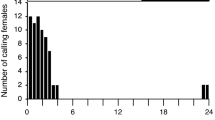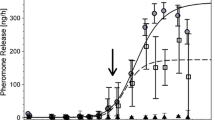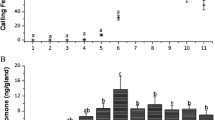Abstract
Pheromones serve key functions in the biology of swarming locusts. However, research has focused largely on the mass-swarming desert locust, Schistocerca gregaria. We extended these investigations to the pheromonal profile of the rarely swarming American bird grasshopper, S. americana (Drury). The headspace of mature gregarious S. americana males contained three characteristic electroantennogram-active components: (Z)-3-nonen-1-ol, (Z)-2-octen-1-ol, and nonanal. These substances were accompanied by aromatics such as phenol that are also released by females and immatures. Male-specific pheromone components were released independently from epidermal gland cells, with the highest emission rate being for (Z)-3-nonen-1-ol from the abdomen and legs. The emission of the major compound, (Z)-3-nonen-1-ol, is stress-sensitive, and coincides with sexual maturity and crowding. The emission pattern strongly supports a role of (Z)-3-nonen-1-ol in the reproductive biology of S. americana. The pheromone is involved in courtship-inhibition and is used as mate assessment pheromone in cryptic female choice. In double mating experiments, females choose sperm of males with high (Z)-3-nonen-1-ol emission. Furthermore the pheromone accelerated maturation of immature adults and supports synchronization of sexual development.








Similar content being viewed by others
References
Amerasinghe, F. P. 1978. Pheromonal effects on sexual maturation, yellowing, and the vibration reaction in immature male desert locusts (Schistocerca gregaria). J. Insect Physiol. 24:309–314.
Assad, Y. O. H., Hassanali, A., Torto, B., Mahamat, H., Bashir, N. H. H., and El Bashir, S. 1997. Effects of fifth-instar volatiles on sexual maturation of adult desert locust Schistocerca gregaria. J. Chem. Ecol. 23:1373–1388.
Boeve, J. L., Gfeller, H., Schlunegger, U. P., and Francke, W. 1997. The secretion of the ventral glands in Hoplocampa sawfly larvae. Biochem. Syst. Ecol. 25:195–201.
Boorman, E. and Parker, G. A. 1976. Sperm (ejaculate) competition in Drosophila melanogaster, and the reproductive value of females to males in relation to female age and mating status. Ecol. Entomol. 1:145–155.
Byers, J. A. 1991. Pheromones and chemical ecology of locusts. Biol. Rev. 66:347–378.
Cook, P. A., Harvey, I. F., and Parker, G. A. 1997. Predicting variation in sperm precedence. Phil. Trans. R. Soc. Lond. B. 352:771–780.
Davenport, A. P. and Evans, P. D. 1984. Stress-induced changes in the octopamine levels of insect haemolymph. Insect Biochem. 14:135–143.
DeGroot, P. and Poland, T. M. 2003. Attraction of Hylastes opacus (Coleoptera: Scolytidae) to nonanal. Can. Entomol. 135:309–311.
Dickens, J. C. 2006. Plant volatiles moderate response to aggregation pheromone in Colorado potato beetle. J. Appl. Entomol. 130:26–31.
Dillon, R. and Charnley, K. 2002. Mutualism between the desert locust Schistocerca gregaria and its gut microbiota. Res. Microbiol. 153:503–509.
Dirsh, V. M. 1974. Genus Schistocerca (Acridomorpha, Insecta). W. Junk, The Hague.
Eberhard, W. G. 1996. Female control: Sexual selection by cryptic female choice. Princeton University Press, Princeton.
Farine, J. P., Everaerts, C., LeQuere, J. L., Semon, E., Henry, R., and Brossut, R. 1997. The defensive secretion of Eurycotis floridana (Dictyoptera, Blattidae, Polyzosteriinae): Chemical identification and evidence of an alarm function. Insect Biochem. Molec. Biol. 27:577–586.
Farine, J. P., Semon, E., Everaerts, C., Abed, D., Grandcolas, P., and Brossut, R. 2002. Defensive secretion of Therea petiveriana: chemical identification and evidence of an alarm function. J. Chem. Ecol. 28:1629–1640.
Fedina, T. J. and Lewis, S. M. 2008. An integrative view of sexual selection in Tribolium flour beetles. Biol. Rev. 83:151–171.
Ferenz, H. J. 1990. Locust pheromones - basic and applied aspects. Bol. San. Veg. Plagas (Fuera de serie). 20:29–37.
Ferenz, H. J. and Seidelmann, K. 2003. Pheromones in relation to aggregation and reproduction in desert locusts. Physiol. Entomol. 28:11–18.
Fuzeau-Braesch, S., Genin, E., Jullien, R., Knowles, E., and Papin, C. 1988. Composition and role of volatile substances in atmosphere surrounding two gregarious locusts, Locusta migratoria and Schistocerca gregaria. J. Chem. Ecol. 14:1023–1033.
Griffiths, J. T. and Thompson, W. L. 1952. Grasshoppers in citrus groves. Univ. Fla. Agric. Exp. Station Bull. 496:1–26.
Grunshaw, J. P., Guermouche, H., Guermouche, S., Jago, N. D., Jullien, R., Knowles, E., and Perez, F. 1990. Chemical taxonomic studies of cuticular hydrocarbones in locusts of the Schistocerca americana complex (Acrididae: Cyrtacanthacridinae): chemical relationships between new world and old world species. J. Chem. Ecol. 16:2835–2858.
Harvey, A. W. 1979. Hybridization studies in the Schistocerca-Americana Complex. I. Specific status of the Central American locust. Biol. J. Linn. Soc. 12:349–355.
Harvey, A. W. 1982. Hybridization studies in the Schistocerca-Americana Complex. II. The Peruvian Locust. Biol. J. Linn. Soc. 17:217–223.
Hassanali, A., Njagi, P. G. N., and Bashir, M. O. 2005. Chemical ecology of locusts and related acridids. Annul. Rev. Entomol. 50:223–245.
Hawkes, F., Rzepka, J., and Gontrand, G. 1987. The scent glands of the male South American locust Schistocerca cancellata, an electron microscope study. Tissue Cell. 19:687–703.
Jago, N. D., Antoniou, A., and Scott, P. 1979. Laboratory evidence showing the separate species status of Schistocerca gregaria, americana and cancellata (Acrididae, Crytacanthacridinae). Syst. Entomol. 4:133–142.
Johansson, B. G. and Jones, T. M. 2007. The role of chemical communication in mate choice. Biol. Rev. 82:265–289.
Jones, T. M. and Hamilton, J. G. C. 1998. A role for pheromones in mate choice in a lekking sandfly. An. Behav. 56:891–898.
Kosal, E. F. and Niedzlek-Feaver, M. 1997. Female preferences for large, heavy mates in Schistocerca americana (Orthoptera: Acrididae). J. Insect Behav. 10:711–725.
Kosal, E. F. and Niedzlek-Feaver, M. 2007. Parental Size Influence on Offspring Phenotype in Schistocerca americana (Orthoptera: Acrididae). J. Orthoptera Res. 16:51–55.
Kroiss, J., Schmitt, T., Schreier, P., Strohm, E., and Herzner, G. 2006. A selfish function of a “social”gland? A postpharyngeal gland function as a sex pheromone reservoir in males of the solitary wasp Philanthus triangulum. J. Chem. Ecol. 32:2763–2776.
Kubo, A., Lunde, C. S., and Kubo, I. 1995. Antimicrobial activity of the olive oil flavour compounds. J. Agric. Food Chem. 43:1629–1633.
Kuitert, L. C. and Connin, R. V. 1952. Biology of the American grasshopper in the south eastern United States. Fla. Entomol. 35:22–33.
Lewis, S. M. and Austad, S. N. 1994. Sexual selection in flour beetles - the relationship between sperm precedence and male olfactory attractiveness. Behav. Ecol. 5:219–224.
Loher, W. 1961. The chemical acceleration of the maturation process and its hormonal control in the male of the desert locust. Proc. R. Soc. Lond. B. 153:380–397.
Loher, W. 1990. Pheromones and phase transformation in locusts, pp. 337–355, in R. F. Chapman and A. Joern (eds.), Biology of grasshoppers. Wiley, New York.
Lovejoy, N. R., Mullen, S. P., Sword, G. A., Chapman, R. F., and Harrison, R. G. 2006. Ancient trans-Atlantic flight explains locust biography: molecular phylogenetics of Schistocerca. Proc. R. Soc. Lond. B. 273:767–774.
Mahamat, H., Hassanali, A., Odongo, H., Torto, B., and El-Bashir, S. 1993. Studies on the maturation-accelerating pheromone of the desert locust Schistocerca gregaria (Orthoptera: Acrididae). Chemoecology 4:159–164.
Mahamat, H., Hassanali, A., and Odongo, H. 2000. The role of different components of the pheromone emission of mature males of the desert locust, Schistocerca gregaria (Forskål) (Orthoptera: Acrididae) in accelerating maturation of immature adults. Insect Sci. Appl. 20:1–5.
Brunnemann, U. 1996. Identifizierung und Synthese von Heuschreckenpheromonen. PhD dissertation. University of Hamburg.
Squitier, J. M. and Capinera, J. L. 1996. American grasshopper, Schistocerca americana (Drury) (Insecta: Orthoptera: Acrididae). Institute of Food and Agricultural Sciences, University of Florida.
Nemoto, T., Kuwahara, Y., and Suzuki, T. 1990. Isolation and identification of male sex pheromone present in the wing gland of Achroia innotata obscurevittella Ragonot (Lepidoptera: Pyralidae). Appl. Ent. Zool. 25:261–264.
Norris, M. J. 1954. Sexual maturation in the desert locust (Schistocerca gregaria Forskål) with special reference to the effects of grouping. Anti-Locust Bull. 18:1–44.
Parker, G. A. 1970. Sperm competition and its evolutionary consequences in the insects. Biol. Rev. 45:525–567.
Perić-Mataruga, V., Nenadović, V., and Ivanović, J. 2006. Neurohormones in insect stress: a review. Arch. Biol. Sci. 58:1–12.
Pierce, A. M., Pierce, H. D., Oehlschlager, A. C., and Borden, J. H. 1991. 1-octen-3-ol, attractive semiochemical for foreign grain beetle, Ahasverus advena (Waltl) (Coleoptera: Cucujidae). J. Chem. Ecol. 17:567–580.
Pureswaran, D. S., Gries, R., Borden, J. H., and Pierce Jr., H. D. 2000. Dynamics of pheromone production and communication in the mountain pine beetle, Dendroctonus ponderosae Hopkins, and the pine engraver, Ips pini (Say) (Coleoptera: Scolytidae). Chemoecology 10:153–168.
Raina, A. K. 1993. Neuroendocrine control of sex pheromone biosynthesis in Lepidoptera. Annu. Rev. Entomol. 38:329–349.
Robacker, D. C. and Hart, W. G. 1985. (Z)-3-nonenol, (Z, Z)-3,6-nonadienol and (S, S)-(-)-epianastrephin: male produced pheromones of the Mexican fruit fly. Entomol. Exp. Appl. 39:103–108.
Rocca, J. R., Nation, J. L., Strekowski, L., and Battiste, M. A. 1992. Comparison of volatiles emitted by male Caribbean and Mexican fruit flies. J. Chem. Ecol. 18(2):223–244.
Schmidt, G. H. and Albütz, R. 2002. Sexual maturation and yellow coloration of adult males in the gregarious desert locust, Schistocerca gregaria, in relation to volatiles emitted (Caelifera: Acrididae). Entomol. Gener. 26:121–141.
Schwab, W. and Schreier, P. 2002. Enzymic formation of flavour volatiles from lipids, pp. 293–318, in T. M. Kuo and H. W. Gardner (eds.), Lipid biotechnology. Marcel Dekker, New York.
Seidelmann, K. 2006. The courtship-inhibiting pheromone is ignored by female-deprived gregarious desert locust males. Biol. Lett. 2:525–527.
Seidelmann, K. and Warnstorff, K. 2001. Ein kombiniertes Y-T-Olfaktometer für Biotests mit großen Insekten. Mitt. Dtsch. Ges. Allg. Angew. Ent. 13:403–408.
Seidelmann, K., Luber, K., and Ferenz, H. J. 2000. Analysis of release and role of benzyl cyanide in male desert locusts, Schistocerca gregaria. J. Chem. Ecol. 26:1897–1910.
Seidelmann, K., Weinert, H., and Ferenz, H. J. 2003. Wings and legs are production sites for the desert locust courtship-inhibiting pheromone, phenylacetonitrile. J. Insect Physiol. 49:1125–1133.
Seidelmann, K., Warnstorff, K., and Ferenz, H. J. 2005. Phenylacetonitrile is a male specific repellent in gregarious desert locusts, Schistocerca gregaria. Chemoecology 15:37–43.
Siljander, E., Gries, R., Khaskin, G., and Gries, G. 2008. Identification of the airborne aggregation pheromone of the common bed bug, Cimex lectularius. J. Chem. Ecol. 34:708–718.
Song, H. 2004. On the origin of the desert locust Schistocerca gregaria (Forskål) (Orthoptera: Acrididae: Cyrtacanthacridinae). Proc. R. Soc. Lond. B. 271:1641–1648.
Song, H. 2005. Phylogentic perspectives on the evolution of locust phase polyphenism. J. Orthoptera Res. 14:235–245.
Song, H. and Wenzel, J. W. 2007. Phylogeny of bird-grasshopper subfamily Cyrtacanthacridinae (Orthoptera: Acrididae) and the evolution of locust phase polyphenism. Cladistics 23:1–28.
Staples, J. K., Krall, B. S., Bartelt, R. J., and Whitman, D. W. 2002. Chemical defense in the plant bug Lopidea robiniae (Uhler). J. Chem. Ecol. 28:601–615.
Sword, G. A. 2003. To be or not to be a locust? A comparative analysis of behavioural phase change in nymphs of Schistocerca americana and Schistocerca gregaria. J. Insect Physiol. 49:709–717.
Symonds, M. R. E. and Elgar, M. A. 2008. The evolution of pheromone diversity. Trends Ecol. Evol. 23:220–228.
Torto, B., Obeng-Ofori, D., Njagi, P. G. N., Hassnali, A., and Amiani, H. 1994. Aggregation pheromone system of adult gregarious desert locust Schistocerca gregaria (Forskål). J. Chem. Ecol. 20:1749–1762.
Torto, B., Njagi, P. G. N., Hassanali, A., and Amiani, H. 1996. Aggregation pheromone system of nymphal gregarious desert locust, Schistocerca gregaria (Forskål). J. Chem. Ecol. 22:2273–2281.
Türker, L., Togan, I., Ergezen, S., and Özer, M. 1993. Novel attractants of Galleria mellonella L (Lepidoptera Pyralidae Galleriinae). Apidologie 24:425–430.
Uvarov, B. 1977. Grasshoppers and locusts: a handbook of general acridology II. Centre for Overseas Pest Research. United Kingdom, Cambridge.
Wood, W. F. and Weldon, P. J. 2002. The scent of the reticulated giraffe (Giraffa camelopardalis reticulate). Biochem. Syst. Ecol. 30:913–917.
Zhang, A., Robbins, P. S., Averill, A. L., Weber, D. C., Linn Jr., C. E., Roelofs, W. L., and Villani, M. G. 2003. Identification of the female-produced sex pheromone of the scarab beetle, Hoplia equina. J. Chem. Ecol. 29:1635–1642.
Zhang, Q. H., Chauhan, K. R., Erbe, E. F., Vellore, A. R., and Aldrich, J. R. 2004. Semiochemistry of the goldeneyed lacewing Chrysopa oculata: attraction of males to a male-produced pheromone. J. Chem. Ecol. 30:1849–1870.
Acknowledgements
The authors are grateful to R. Csuk (Dep. Org. Chem., Univ. Halle) for the synthesis of (E)-3-nonen-1-ol and (Z)-2-octen-1-ol as basis for the identification of stereoisomers. The sterioisomeric analysis was kindly executed by P. Lindemann (Dep. Pharmac. Biotech., Univ. Halle). R. Gerlach (Dep. Radiation Therapy, Univ. Halle) provided technical support for the sterilization of locusts. We thank S. Hertel for technical assistance and maintenance of the locust culture. Financial support from Max Planck Gesellschaft is gratefully acknowledged.
Author information
Authors and Affiliations
Corresponding author
Electronic supplementary material
Below is the link to the electronic supplementary material.
Table S1
Accurate mass spectra of compounds 1-3 measured on Masspec GC-MS instrument; Peak 1 NIST database hit (Purity/Mixture) 961/963 for 2-octen-1-ol, peak 2 hit 983/983 for nonanal and the major peak 3 hit 989/989 for 3-nonen-1-ol (PDF 16 kb)
Fig. S1
Adducts of acetylation and following DMDS derivatisation of (Z)-3-nonen-1-ol (a) and (Z)-2-octen-1-ol (b) (PDF 24 kb)
Rights and permissions
About this article
Cite this article
Stahr, C., Svatoš, A. & Seidelmann, K. Chemical Identification, Emission Pattern and Function of Male-Specific Pheromones Released by a Rarely Swarming Locust, Schistocerca americana . J Chem Ecol 39, 15–27 (2013). https://doi.org/10.1007/s10886-012-0233-4
Received:
Revised:
Accepted:
Published:
Issue Date:
DOI: https://doi.org/10.1007/s10886-012-0233-4




